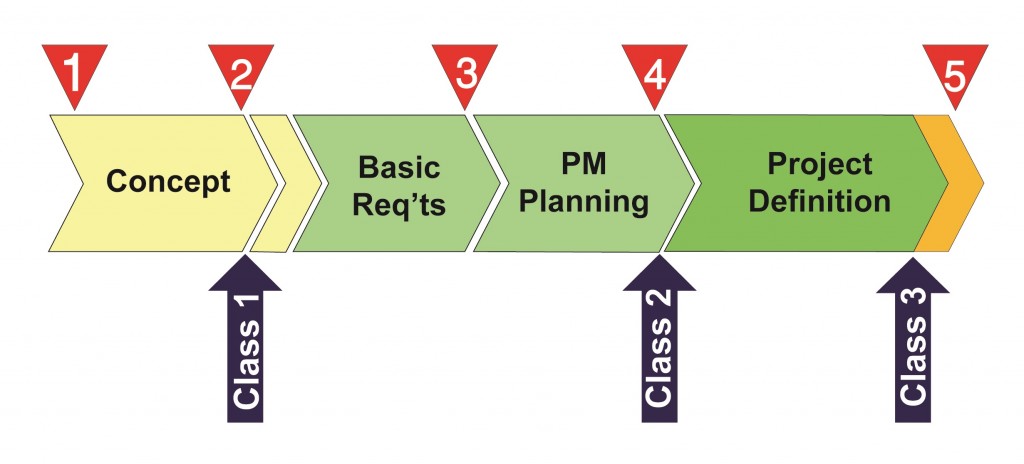This blog post is also from our upcoming book, Redefining the Basics of Project Management, scheduled for second quarter 2014. We publish this chapter in two parts.
Project Estimates across the Project Life Span
In the previous chapter[1], we identified two major funds approval and three budgeting points. We also stated that an input to the decision making process at each of the fund approvals points is an updated estimate of cost and time. This leads to the questions:
- What are the leading practices for how many estimates are required for a project?
- Across the project life span, do we need one, two, or three estimates?
- What about four or five estimates?
We are sure that a reader from banking, information technology, or marketing is now thinking that the author has completely lost it!
The Association for the Advancement of Cost Engineers, International defines five different and distinct estimates classes for the life span of the project (AACE® International n.d.)[2].
For some domains and in certain situations, the use of five estimate classes per AACE® is appropriate. We must stress, however, that not every project will require five estimates. Even in capital-intensive industries, the leading practice is three estimates.
Proposed Approach
What are the three estimates classes that we have just mentioned?
We propose the following as a leading practice in the application of CAM2P™, even on small projects. These are similar to, but not 100% aligned with AACE guidelines.
Class 1 Estimate
We call this first estimate the ‘rough order of magnitude’ (ROM) estimate, although conceptual or study estimates are also common names.
This estimate is a high-level estimate, since not enough project details have been developed during the concept phase. Therefore, it is the least accurate of the three proposed classes.
The primary use of this class is for the feasibility study, in which the team performs the project’s financial analysis. For commercial projects, the team focuses on financial return and for social or governmental projects, on justifying the expenditures in comparison to social or community benefits.
In either case, we use this Class 1 Estimate to make a decision at stage gate 2 (SG2) on whether to authorize the project, issue the PAD, and give the go decision to proceed on to the next stage of the project. Further, as mentioned in the previous chapter, approval at SG2 leads to the first budget approval and inclusion of the project in the organization business or operating plan.
To develop this estimate, project teams typically use historical data from previous projects. Such historical data will typically be at the project level and contain minimal details. In the absence of this information, teams depend on expert judgment and possible quotations from third parties such as vendors and service providers, although this is not always practical or appropriate for a given project.
Keep in mind that the term ‘estimate’ refers to both cost and time. In the context of the book, unless we specifically mention cost or time, the use of the term ‘estimate’ is for both. Therefore, the Class 1 Estimate is an estimate of the approximate project cost and expected project duration.
Class 2 Estimate
This is an update to the Class 1 Estimate and might be called the ‘planning estimate’ in CAM2P™; ‘budgetary estimate’ is also common term. We develop this estimate during the project launch stage, with project management planning.
The accuracy of this estimate is better than the Class 1 Estimate. It is not suitable for project detailed control since it does not yet contain enough detail; it is still more qualitative than quantitative.
The main purpose of this estimate is the enhancement of management’s understanding of the project estimate, to determine if it is still in line with expectations. Further, if advance funding is required, the organization will require this estimate to request its approval at stage gate four (SG4).
To develop this estimate, the project team typically uses a blend of historical data from previous projects and other estimating techniques. This varies within industries and companies and is a function of the project management maturity in the organization. We discuss estimate accuracy in relation to project management maturity at the end of this chapter.
Class 3 Estimate
This is a crucial estimate, which the project team develops during the project definition stage. This estimate is called the ‘detailed estimate’ in CAM2P™; ‘semi-definitive estimate’ and ‘funding estimate’ are also common terms.
You may also encounter the term ‘control estimate’, since this estimate is used after approval to develop the performance management baseline. The project team then uses this for project control purposes during the implementation stage.
The project team uses the information from the project definition stage, and the project planning information, including the detailed work breakdown structure, to develop the Class 3 Estimate. With this level of detail, the estimate is sufficiently accurate (+/- 10%, as mentioned earlier) and is suitable as the basis for the final project approval at stage gate five.

[2] The AACE International Recommended Practice No. 17R-97 states, “Five cost estimate classes have been established. While the level of project definition is a continuous spectrum, it was determined from benchmarking industry practices that three to five discrete categories are commonly used. Five categories are established in this guideline as it is easier to simplify by combining categories than it is to arbitrarily split a standard.” (AACE® International n.d.).


Trackbacks/Pingbacks